LivestockResource F&R
Your direct source for livestock news and information
In this Issue:
1 Livestock Risk Protection
One tool in a beef producer’s risk management toolbox is the government subsidized Livestock Risk Protection (LRP) program. This article discusses the flexibility of LRP and the multiple applications from insuring an unborn calf crop to finished cattle. The next issue will discuss other risk management tools available to protect against market volatility.
13 Sustainability Credit


Progressive livestock production has, arguably, moved the needle on sustainability more than any industry. Until now, the systems to quantify our progress has been limited. The opportunity has arrived to document site-specific contributions to greenhouse gas emissions (GHG).
19 Clear Sailing
Drought is having a significant impact on a large area of beef production and must be factored into any marketing forecast. However, supply and demand fundamentals point to higher cattle prices for the next few years. Global beef demand and consumer acceptance is at an all time high.
23 Tax Flattener
It isn’t often Hooter McCormick “gets the last laugh.” Fortuitously ending up with a new accountant supremely skilled at “fuzzy math” was the solution to Hooter’s tax problems.
Livestock Risk Protection Program Provides Cattlemen with Risk Management Options


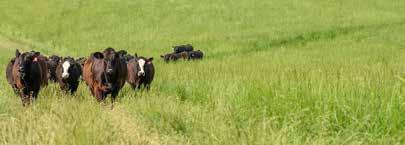
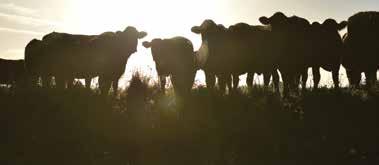
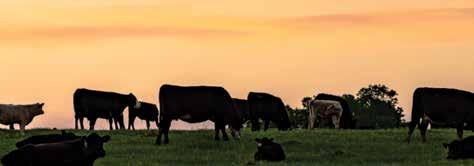
 By Sara Gugelmeyer
By Sara Gugelmeyer
Cattle producers are typically tough, independent types who really lean into the idea that they can handle anything coming at them. For generations, ranchers have worn their tenacity proudly, like a badge, refusing any help. However, the cattle market is not the same as it was in our father’s heyday, and certainly not our grandfathers’. Speculating traders, for one, have changed the game as well as outside market pressures like packing plant fires and pandemic-causing viruses. These pressures, which no one, it seems, can control, are why it’s impera-
tive that just as we’ve updated our vaccination and feeding programs, we also need to update or adopt for the first time, true risk management strategies.
The first, and maybe most simple risk management strategy now offered is the Livestock Risk Protection (LRP) program, which is run and partly subsidized through the USDA’s Risk Management Agency. In some ways, LRP is similar to traditional crop insurance, and is designed to help ranchers traverse huge market swings without having to file for bankruptcy.
PRSRT STANDARD U.S. POSTAGE PAID Jefferson City, MO 65101 Permit #303 Spring 2022 | Volume 5, Issue 3
Continued on page 4
Published by Farmers & Ranchers Livestock, Salina, Kansas
Nematodirus (shown here), also known as the thread-necked intestinal worm, is an unsightly parasite that causes infections marked by diarrhea and loss of appetite − both of which open the door for other internal parasites to cause even more damage.
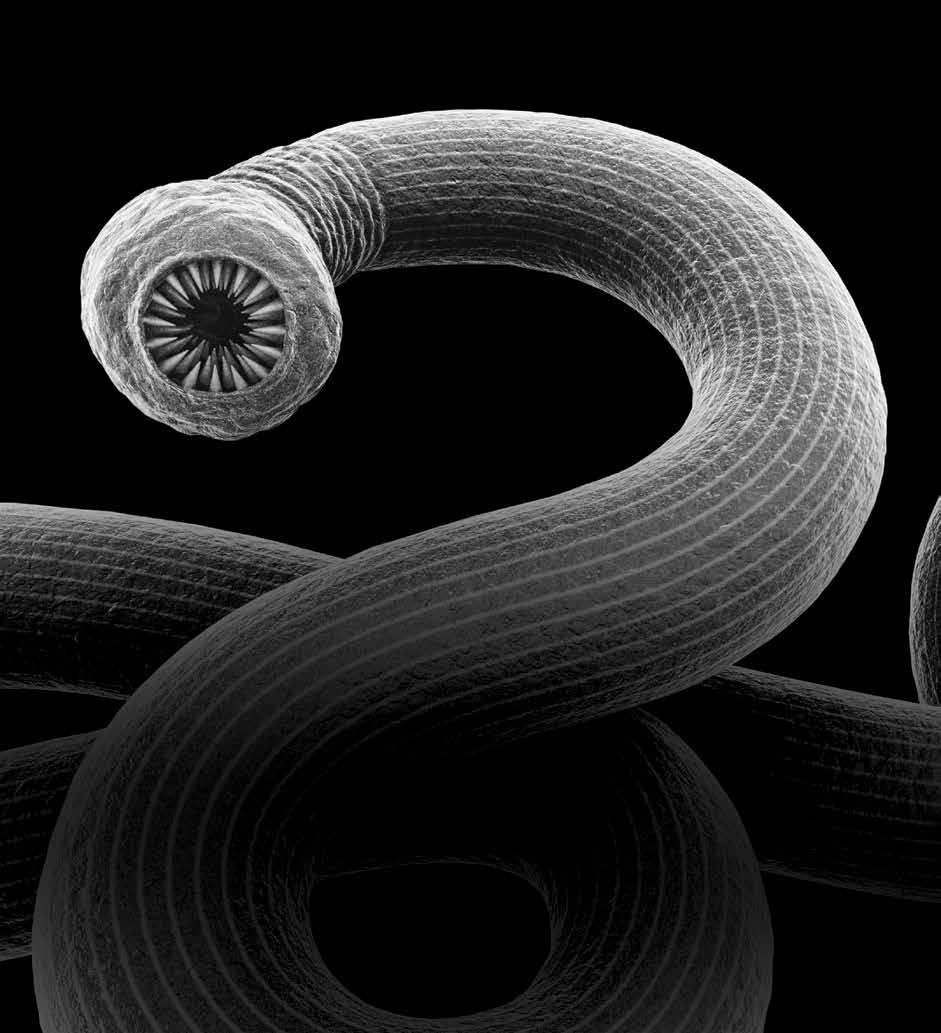
Choose Safe-Guard® (fenbendazole) when you deworm to take out more profit-eating parasites.
SAFE-GUARD is proven to kill 98.7% of worms, remaining powerful and effective, even in the face of parasite resistance.1 Choosing two dewormers from two different classes (like SAFE-GUARD + ivermectin) can help ensure you’re getting the toughest parasites – and helping slow the growing issue of parasite resistance.
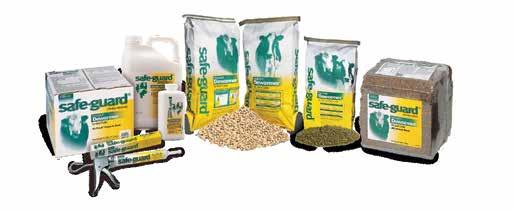
BITE BACK AT KILLMOREWORMS.COM
IMPORTANT SAFETY INFORMATION: Do not use in beef calves less than 2 months old, dairy calves and veal calves. A withdrawal period has not been established for this product in pre-ruminating calves. Additionally, the following meat withdrawal and milk discard times apply: SAFE-GUARD Paste: Cattle must not be slaughtered for 8 days. For dairy cattle, the milk discard time is 96 hours. SAFE-GUARD Suspension: Cattle must not be slaughtered for 8 days. For dairy cattle, the milk discard time is 48 hours. SAFE-GUARD En-PRO-AL Type C Medicated Block: Cattle must not be slaughtered for 11 days. For use in beef cattle only. SAFEGUARD 20% Protein Type C Medicated Block: Cattle must not be slaughtered for 16 days. For use in beef cattle only. SAFE-GUARD medicated feed products (pellets, cubes, free-choice mineral, or free-choice liquid): Cattle must not be slaughtered for 13 days. For dairy cattle, the milk discard time is 60 hours.
1Reinhardt CD, et al. A fenbendazole oral drench in addition to an ivermectin pour-on reduces parasite burden and improves feedlot and carcass performance of finishing heifers compared with endectocides alone. J Anim Sci. 2006;84(8):2243-50.
doing business as Merck Animal Health, a subsidiary of Merck & Co., Inc. All rights reserved. US-SFG-200400001
MAHCattle.com • 800-521-5767 ©
2022 Intervet Inc.,
Owner: Farmers & Ranchers Livestock, Mike Samples, Salina, Kansas (785) 826-7884
By Deb Norton
Call it old age or social media exhaustion, but my tolerance for the absence of critical thinkers or those willing to actively engage in “fixing” a problem rather than burning down the house is now at subzero. All too frequently, memes appear on my social media pages with a big, bold, red, white and blue headline. I SUPPORT BEEF BORN IN THE USA. Well, what farmer or rancher in the U.S.A. doesn’t? I mean, seriously. Yet, the meme is intended to escalate opposition to any of that “foreign beef”, and insinuates imports directly compete with American beef. Just to be clear, I, too, support the gargantuan efforts of every meat protein producer in America. But, making imports the villain in an already stressed and stretched food supply chain is a fool’s errand.
Global trade is a two-way street. Without imports, we don’t have exports. If you are the shopper in your family, at some level, you appreciate value the options that global trade affords us. Currently, my pantry is stocked with onions from Peru, grapes from Chile, avocados from Mexico, hot house grown tomatoes and creamer potatoes from Canada. Global trade agreements are never perfect, and geopolitics can influence the markets. Yet, global trade to an American consumer means my choices are inordinately more affordable, more diverse, and ultimately, healthier.
When I replace my consumer, Sam’s Club shopper’s appreciation for value
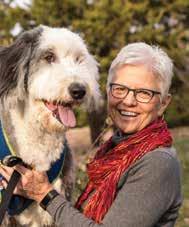
and choice, along with my nearly 50 years as a beef industry marketer and dig deeper, the facts are interesting and the upside potential to increase the value of beef exports is incredibly exciting.
Derrell Peel, Oklahoma State University Cooperative Extension livestock marketing specialist, extensively studies export and import trends of beef. He recently reported, “Exports and imports help sort out the complex set of beef products in domestic and international markets to maximize the value to U.S. beef producers. Beef exports add value by increasing the quantity of total beef sales, allowing the United States to sell more beef to more places,” Peel said. “Also, beef exports add value by selling beef at higher prices.” Peel also states, “Beef imports are largely driven by the enormous market for ground beef in the United States. Approximately 72 percent of beef imports are lean trimmings used primarily to make hamburger. In 2016, ground beef consumption was estimated at 25 pounds per capita, making up 45 percent of total U.S. retail beef consumption. Export markets provide a way to ship out some of those lower valued cuts, thereby focusing domestic demand on higher valued beef. Every pound of lower-valued beef product exported is one less pound that competes with increased total demand and value for beef in the domestic market.”
On November 12, 2021, the National Provisioner reported the September 2021 beef export value equated to $447.46 per head of fed slaughter, up 63 percent over 2021. Let that sink in. The value of exported beef added more than $447 to every carcass.
A recent report from the U.S. Meat Export Federation states, “U.S. beef exports greatly exceeded previous volume and value records in 2021, surpassing $10 billion for the first time, according to year-end data released by USDA and compiled by the U.S. Meat Export Federation (USMEF). December beef exports totaled 121,429 metric tons (mt), up 1% from a year ago, while value climbed 33% to $991.8 million—the third largest month on record. These results pushed 2021 volume to 1.44 million mt, up 15% from a year ago and 7% above the previous record set in 2018. Export value soared to $10.58 billion, up 38% from 2020 and shattering the previous record (also from 2018) by 27%.”
USMEF reported Japan remains the leading destination for U.S. beef, up 5% from 2020. Exports to Korea were up 14% and broke the record set in 2019. Exports to China, although more complicated, exceeded $2 billion, up 114%
F&R Livestock Resource page 3
www.CogentIdeasInc.com
Resource F&R
Farmers &
Old
40
•
(fax) FandRLive.com find us on Facebook Facebook.com/FarmersAndRanchersLivestock
F&R Advertisers / Page / Sale Date Produced by
Livestock
Volume 5, Issue 3 Spring 2022 Published quarterly by
Ranchers Livestock, Salina, Kansas 1500 W.
Hwy
Salina, Kansas 67401 (785) 825-0211
(785) 826-1590
Editor: Deb Norton, Deb@CogentIdeasInc.com Production Coordinator: Julie Tucker Graphic Designer: Daric Wells Editorial Assistants: Dixie Russell, Dave Cumpton Contributing Editors: Wes Ishmael, Paige Nelson, Sara Gugelmeyer
To be added or removed from our mailing list, contact
F&R Livestock Resource is published quarterly with mail dates of January 15, March 1, August 15 and October 1 by Farmers
25 From the
Contributing Artist: Ted Foulkes Sales Jay Carlson Carlson Media Group, LLC (913) 967-9085 Subscriber Questions:
Julie Tucker, Julie@ CogentIdeasInc.com or (785) 408-1214.
& Ranchers Livestock, Salina, Kansas. Continued on page
Editor
Farmers & Ranchers Livestock Commission Co., Inc. Salina, Kansas • (785) 825-0211 Farmers & Ranchers Upcoming Sales and Events Cow Sales March 15, April 19, May 3 Bull Sales Don Johnson March 7 New Frontier Bucking Bull Sale March 26 Spring Spectacular Catalog Horse Sale Ranch Horse Competition (Catalog Horses Only) May 20, 6:00 PM Roping & Performance Preview May 20, 1:00 PM, May 21, 7:30 AM Sale May 21, 10:00 AM Cattleman’s Choice 21 March 19 Circle S 20 April 2 Gardiner Angus Ranch 15 April 2 GenePlus Brangus 23 March 22 Green Garden 18 April 4
Farms 17 April 11 Kaiser Angus 25 April 7 Katzenmeier Cattle Co. 22 Private Treaty
Cattle Co. 11 March 26-28
Ranches 19 March 18
OBC April 22
Farms 10 Private Treaty through July 4
Cattle Co. 24 April 18
Brothers 12 March 28
Farms 6 March 26
Ranch 9 March 15 Seedstock Plus 4 March 5, 12, 26
Ranch 18 March 24-25 Woodbury Farms 10 March 16 “Exports and imports
the
of beef products in domestic
markets to
value
beef producers...” For advertising information, contact: Jay Carlson | Carlson Media Group (913) 967-9085 • Jay@CarlsonMediaGroup.com Don’t miss our next issue August 1, 2022. Old Age or Social Media Exhaustion!
Jorgensen
Leachman
Mushrush
NextGen
Nichols
Ohlde
Oleen
Sandhill
Schrader
Vermilion
help sort out
complex set
and international
maximize the
to U.S.
But it helps that the program is administered
like Andy Cunningham of AgDefense Risk Management or Joanie Grimes of ICAP Crop Insurance.
Cunningham is not only an insurance salesman, he farms and operates his own commercial and registered cow-calf herds. Joanie Grimes is a veteran in the crop and livestock insurance business, having fought to best represent her clients needs for 23 years.

To put it simply Cunningham says, “LRP is an insurance product that works a lot like a put option. The differences are you can insure any amount or head count of cattle, unlike a put which needs to be 50,000 lb. load lots. Also, you can pick a coverage period that expires every month, whereas put options expire only in months with feeder cattle contracts. Finally, with LRP, you pay at the end when the policy expires, versus a put where you pay in advance. And the most appealing difference, because of the subsidy, LRP is consistently 35 to 55 percent cheaper than a put for feeder cattle. For fed cattle, it is usually 10 to 25% cheaper than a put.”
Grimes explains some different scenarios that are common with her customers.
“This works if you are a cow-calf producer and you like the way the market looks but the calves have not yet been born. You know you will be selling them at a particular period of time. You can place insurance on the time when they would be marketed to protect your inputs and potential selling price,” she says.
“Another for instance,” she continues, “is you are feeding a bunch of 900 pounders. Let’s say, you are looking to finish them out after they come off grass. You can put 13 weeks of insurance on them to protect yourself against price decline.”
Cunningham says a lot of his customers are commercial cow operations. “In our experience, this has been a really good tool for the cowcalf producer. They can lock in a floor price on their calf crop and they don’t have to do it in load lots.”

How it Works
Livestock Risk Protection is designed to insure against declining market prices. There are a variety of coverage levels and insurance periods to match the time the feeder cattle would normally be marketed.
The coverage price is a percentage of the expected ending value. This value and associated rates are based on the current day’s closing future prices, volume and volatility. Actual ending values are based on weighted average prices from the Chicago Mercantile Exchange Group Feeder Cattle Index for feeder cattle coverage. For fed cattle, actual ending value is calculated by the Agricultural Marketing Service’s 5 Area Weekly Weighted Average Direct Slaughter Cattle. Coverage prices ranging from 70 to 100 percent of the expected ending value are available. Endorsement lengths are in incre-
ments of 13, 17, 21, 26, 30, 34, 39, 47 or 52 weeks. For feeder cattle there are two weight ranges, under 600 lbs. and 600-900 lbs. For fed cattle coverage weights are 1000 to 1400 lbs.
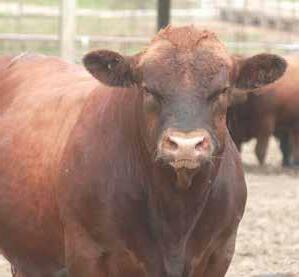

At the end of the coverage period, if the actual ending value is below the coverage price, the policy holder will be paid an indemnity for the difference between the coverage and the actual ending value.
The insurance premium is either subtracted from the indemnity amount when the check is cut, or in the event there is no indemnity paid, the policy holder is billed for the premium.
“The premium is a cost and you’re going to pay that when your policy expires either way,” Cunningham says. “Have I ever had a customer that said, ‘I wish I would have taken the risk and not had to pay the premium?’ Sure, that’s happened. But you have to remember this is not a speculation tool. It’s an insurance policy.”
Cunningham likens it to insurance on your pickup. “In a perfect world,” he says, “you pay the premium and never have a claim. You don’t want to go out and wreck your pickup so you have to use the insurance. But it gives you peace of mind to have it, should something bad happen.”
It’s important to use this as one tool in your tool bag, Grimes emphasizes.
“I think LRP can be a very good
page 4 Spring 2022 Continued from page 1 Arkansas Bull Sale March 5, 2022 * Hope Livestock, Hope, AR Selling 70 Angus, Balancer & Gelbvieh Bulls! 2 yr olds & 18 months! Red Reward Bull & Female Sale March 12, 2022 * Wheeler Livestock, Osceola, MO Selling 60 RED Balancer & Gelbvieh Bulls & RED females! Registered & Commercial! South Missouri Bull & Female Sale March 26, 2022 * Joplin Regional Stockyards, Carthage, MO Selling 150 BLACK Angus, Balancer & Gelbvieh Bulls! 18 months & yearlings! Also BLACK females! Registered & Commercial! OVER 400 Bulls will sell in Seedstock Plus Sales this spring! CALL FOR YOUR CATALOG TODAY! 877-486-1160 • Guaranteed Sight-Unseen Purchases! • Free Trucking on every bull! No fine print! • The best disposition & soundness sort! • Extensive Data & Genomic EPDs! • All Bulls Are Semen & Trich Tested! • Over 200 RFI tested bulls sell in these sales! • Videos of sale bulls on website the week before the sale! www. dvauction.com or www.seedstockplus.com Bid & Buy at: DVAuction ALL SALES! Like all USDA programs,
through licensed crop
the wording can be confusing and hard to follow.
insurance agents
Joanie Grimes, ICAP Crop Insurance
Andy Cunningham, AgDefense Risk Management
Where do you think the phrase “dropping like flies” came from?
Count on Y-TEX ® insecticide ear tags to knock out flies, ticks and lice.

Insect pests can wreak havoc on your cattle, from reducing weight gains to carrying costly diseases like pink eye. That’s why it pays to protect your herd with the proven performance of Y-TEX® insecticide ear tags. Y-TEX® tags control a wide range of livestock pests, including horn flies, face flies, stable flies, black flies, Gulf Coast and spinose ear ticks and lice.
So when it’s time to protect your cattle from flies, ticks and lice, look for the insecticide tags that put a stop to profit-robbing pests: TRI-ZAP ™ , MAX 40 ™ , XP 820 ® , OPtimizer ®, PYthon® II, and PYthon® II Magnum™from Y-TEX®




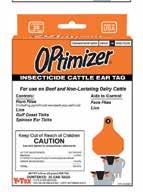
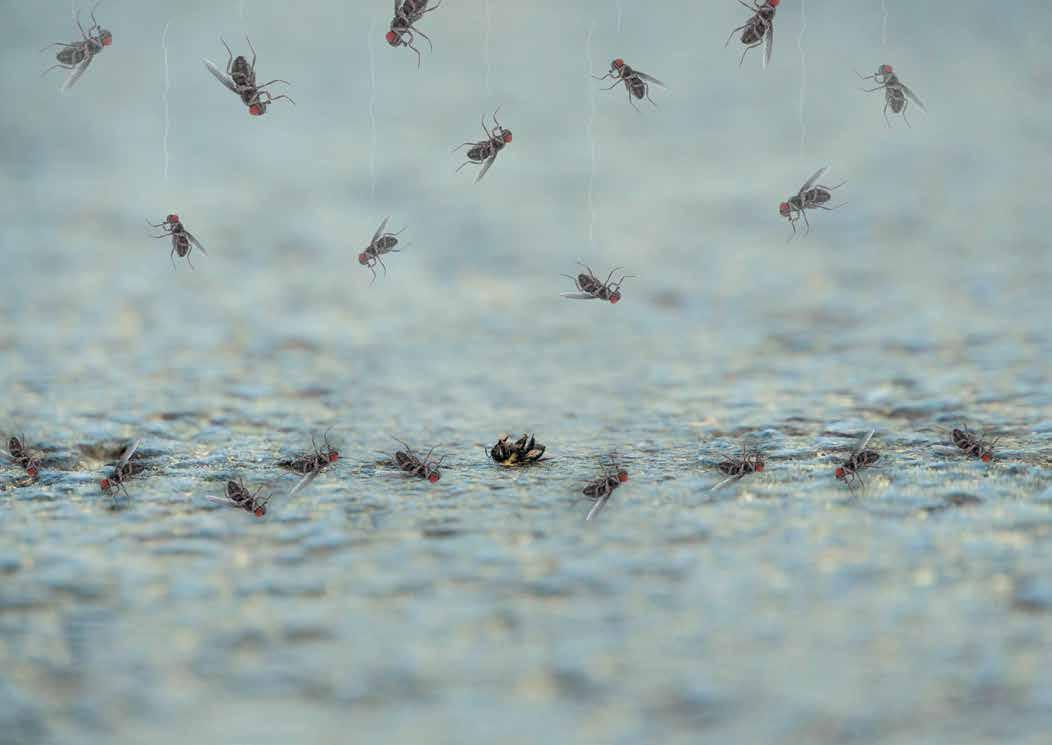
Always read and follow label directions. All brands shown are trademarks or registered trademarks of Y-TEX® Corporation. © 2020 Y-TEX® Corporation.

tool to supplement what people are already doing with their marketing plan,” she says. “It can be used in addition to a forward contract program if the opportunity is there.”
Getting started
The process starts with an application with a licensed crop/livestock insurance agent. It’s basically like setting up an account and there’s no money required, it just gets you in the system, Cunningham explains. The application asks for basic info like name, SSN, and the location where the cattle are primarily going to be.

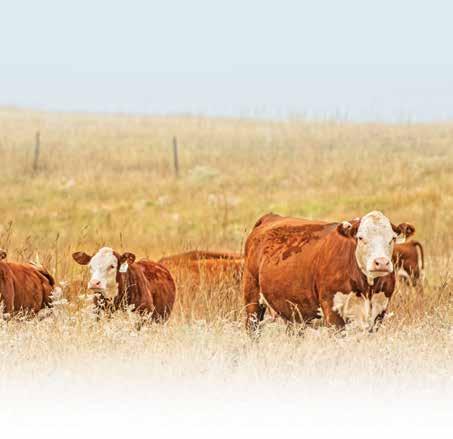
“Everyone fills out the application to be eligible for the insurance,” Grimes explains. “You can put that in place well in advance and not have any specific coverage endorsements yet.”
Cunningham says, “Once you’re in the system, anytime, whether it’s a day or a year later, should you decide to put some cattle on the policy, then all you have to do is call and I can help you with an endorsement.”

It’s at this time that there are some options to consider. Of course, you’ll need to know how many head, and their weight, as well as the planned marketing date.
Coverage percentage options are available. What does this mean? Well, the higher the coverage percentage, the less risk, but also the higher the
premium. Each producer must determine how much risk he or she wants to be exposed to.
Cunningham explains, “The higher the coverage and the longer you set the policy up for, the more expensive it is because there’s more room and time for risk. We can usually count on the premium ranging between $3 and $6 a hundredweight for the highest coverage level.”
Grimes gives an example, “At 90 percent coverage on a group of fed cattle you are planning to feed for 13 weeks, the premium is roughly $7 a head which to me is very economical. For that same group of cattle and period but with 98 percent coverage, it’s close to $30 per head. So the range of premiums varies depending on the amount of tolerance you are willing to accept.”
The coverage percentage is strictly up to the producer. Grimes says, “If the producer is very sound in his financial situation, but he feels the market could turn down on him, he may want to buy lower percentage coverage. He just wants to make sure he covers his input costs. Someone who is highly leveraged or has a lot more in the cattle, he would pick the higher coverage level.”
Things to Consider
There is some flexibility in marketing dates should things not go
page 6 Spring 2022
Proven in the pasture by commercial beef producers for seven generations. Kevin & Vera Schultz • Tyler & Hannah Schultz 2048 280th Avenue • Haviland, KS 67059 Kevin’s Cell (620) 546-4570 •Tyler’s Cell (620) 546-1574 Kevin@SandhillFarms.com • www.SandhillFarms.com • Ron & Arnita Schultz Free Delivery on All Registered Cattle • U.S. Premium Beef Delivery Rights 5% Repeat Buyer Discount • One Year Complete Guarantee OUR MOST ACCURATE “REPORT CARD” comes from our customers Watch the sale and bid live online. Seedstock production isn’t a one size fits all business. We rely on “report cards” from our commercial customers to make certain we produce cattle that fit all environments, across all production sectors. BMI$: +400 / 15% BII$: +496 / 10% CHB$: +146 / 2% 2022 BULL SALE AVERAGES Saturday, March 26, 2022 • 1 PM At the farm near Haviland, KS Selling 280 Head 130 Registered Polled Hereford Bulls 25 Registered Hereford Heifer Pairs With Heifer Calves 100 Commercial Heifers: 60 Hereford • 30 Black Baldy • 10 Red Baldy Sandhill Farms HEREFORD PRODUCTION SALE Sandhill 4.5x12.875 4c-F&R.indd 1 2/14/22 3:35 PM

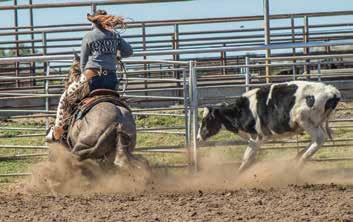
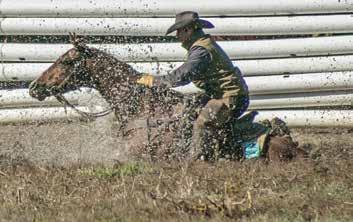
FARMERS & RANCHERS LIVESTOCK COMMISSION COMPANY, INC. MAY 20th 1 PM — Rope Horse Preview 6 PM — Ranch Horse Competition MAY 21st 7:30-9:30 AM — Preview 10 AM — Sale Starts Selling 300 Rope, Ranch and Family Horses SpectacularSpring Kansas Connection for Ranch & Rope Horses 72 HOUR SOUNDNESS GUARANTEE 785-825-0211 | FAX: 785-826-1590 | SALE MANAGER: MIKE SAMPLES 785-826-7884 KYLE ELWOOD (CELL) 785-493-2901 M AY 20 - 21, 2022
according to plan, Cunningham says. “According to the rules, you can sell the cattle up to 60 days in advance of the policy expiration.”
However, the policy still settles on the coverage date, there’s no way to change that. So if you sell the cattle early, you are exposing yourself to risk should the feeder cattle index go up before the ending date of the LRP contract.

Cunningham gives an example, “Say you were planning to graze out your triticale, and the cattle were go -
ing to come off March 15. But things changed and you decide to bale the trit, you can pull the cattle off early, sell your cattle and the policy will still be good.”
You would be exposed to price risk between the date of the actual sale
and the ending value of the contract, though.
Another thing that can happen, Cunningham says, is that producers change their minds and decide to keep heifers instead of sell them as previously planned.
“Say you have a policy for your heifers, but then you decide you want to keep them and make cows out of them. When the policy expires on those heifers it’s going to settle so you either owe a premium or file a claim even though you didn’t sell them.”
So yes, it’s possible to get paid an indemnity on heifers that never changed hands. Or you may have to pay a significant premium on them even though you retained ownership.
Why Not Try It?
Grimes says in her experience, it’s best for customers to try it on a group of cattle to really get the feel for how it all works.
“Just take a pen of cattle and we will put some coverage on them, so you can go through the steps and really grasp it.”
Cattleman Brice Sager of Balko, Oklahoma, decided to give it a go a few years ago. He runs a 400-head commercial cow/calf operation in addition to a preconditioning yard and wheat pasture program.
“I had heard a little bit about LRP and went to a meeting at the Beaver (Oklahoma) sale barn about it,” Sager says.
His home and auto insurance agent happened to be Andy Cunningham’s wife, and she had mentioned the program as well. Prior to trying it, he had been using some forward contracting for cattle coming off of wheat or out of his yard, but wasn’t able to get all his cattle contracted. Then the dramatic price swing of COVID-19 hit.
“Of course, everybody went through that,” Sager says, “I had eight loads turned out and only had one load contracted. We took a bath on everything else. I thought to myself how tired I was of this.”
With the next pen of cattle, he used the LRP program with Cunningham’s help. Now he is going on his third year of insuring all of his cattle through LRP. He uses it to insure his calf crop to 500 lbs. He uses it on feeder cattle he buys to add pounds in the yard or turn out on wheat. He also buys insurance when feeding out cattle.
“I partner on some fed cattle, and we sent some to the feedyard recently. I called the day they left here and got insurance on them,” he says.
For him, LRP is much simpler and easier even than forward contracting.
“Sometimes I will do both but the LRP is easier. With a forward contract, you have to put the weight on them, and have slides to factor into it. With LRP, I just call and say I have 100 head

page 8 Spring 2022


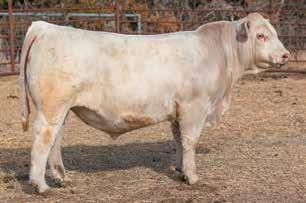

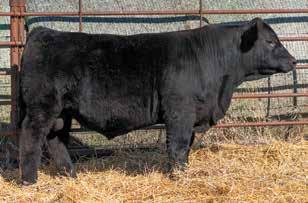
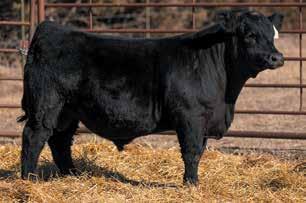
F&R Livestock Resource page 9 TUESDAY, MARCH 15, 2022 | 1:00 PM AT THE RANCH Top End Bid Off | 80 Charolais & SimAngus Bulls on Test • 20 TH ANNUAL BULL SALE • Offering a high caliber set of sons from these breed leading sires to enhance predictability and uniformity in your next calf crop. Charolais Sires: LT Affinity, LT Anthem, LT Patriot, Saint Christopher, TR CAG Carbon Copy, WC Milestone Simmental Sires: KCC1 Exclusive, TJ Gold, OMF Epic, CCR Boulder, CCR Cowboy Cut SCHRADER R ANCH Spencer, Laci, Weston & Josi Schrader Home. 785-488-2135 | Spencer. 785-488-7204 2118 Oxbow Road Wells, Kansas 67467 email: schrader@twinvalley.net For more sale information, videos & the sale catalog visit our website www.schraderranch.com SUTHER FEEDS - DIRECT LINK Dan Suderman. 620-381-1014 Spencer Schrader. 785-488-7204 QUALITY... NO MATTER WHAT COLOR 158J Sired by TR CAG Carbon Copy 1114J Sired by Saint Christopher 142 Sired by LT Anthem 128J - 3/4 SimAngus Sired by TJ Gold 1148J - 3/4 SimAngus Sired by KCC1 Exclusive 1124J - 1/2 SimAngus Sired by CCR Boulder Requestcataloga today
Our bull buyers are all unique. Their needs are our needs and we understand the best time to buy a bull is different for all. Because of this, we strategically plan to have a great selection of bulls available at private treaty throughout the Spring sale season.
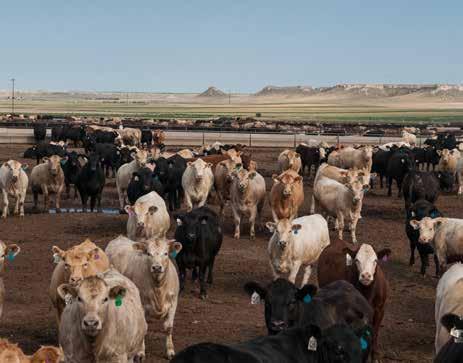
At Nichols Farms, all of our sale bulls are backed by a cowherd with 70 years of selection pressure. We breed for growth, carcass traits, mothering ability, sound feet and good disposition. If a cow does not produce, she goes to town.



We have developed six genetic lines. All different, all with various breeding strengths and reasons to use.
We invite you to come take a look or give us (Dave or Ross) a call to discuss which genetic line works best for you. Should you want to give us a call and take advantage of our “Sight Unseen Purchase Plan,” this comes with our satisfaction guarantee. We offer this with confidence because of the powerful bull lineup we offer throughout the sale offering.
of steers, I am going to market them in March at 750 lbs., and I am done.”
Grimes says it is ease of use and cost savings that makes the LRP program so attractive. “There is a lot of flexibility and it’s an easy product to administer because at the end of the period if the index is less than what you locked in, a check is automatically cut to you. It is not painful for the producer in any way.”
Also, for larger producers, the subsidy can result in a lot of cost savings. Be aware though, there is a 6,000 head limit per contract period and 12,000 head limit per crop year.
Sager admits that a lot of people
have trouble understanding exactly how it works. “It’s got a little leeway in it. If I insure them and the expiration day is May 12, I don’t have to sell them that exact day. There is a little time in there I can use. I plan that out, though, and I market those cattle as close as possible to when that LRP expires.”

He says for example, if he holds them or sells them early, the market could crash. “Two or three weeks can make a big difference. I try to keep it within a week window or even tighter. I want to get those cattle marketed quickly so it all works out like it should.”
But what about when you have to write a check for that premium? Sager
Nichols Farms has made a major investment in a C-lock SMART-FEED feed intake system. This Nichols Farms unit will handle about 300 bulls per test cycle. The second cycle is for the Hybrid and Composite bulls. Each cycle gets actual feed intake, live body weights, rate of gain (ADG) and residual rate of gain (FCR). One cost for beef animals is the feed/forages that accounts for 75% of the retail cost of a beef steak. With corn priced at $5.80 bushel and big round bales of fescue and brome hay is fetching $100, the handwriting is on the wall.
page 10 Spring 2022 Annual 11th Featuring these sires: Bull Female Sale MARCH 16, 2022 | 6 P.M. TRUE NORTH | STUNNER | JUSTIFIED | BEAST MODE MAINSTAY | NAVIGATOR | RAINMAKER WOODBURYFARMSKANSAS.COM OVERBROOK LIVESTOCK COMMISSION COMPANY | OVERBROOK, KS 50 YEARLING BULLS | 50 OPEN YEARLING HEIFERS 20 COMMERCIAL FIRST CALF HEIFER PAIRS Howard Woodbury (785) 241-0515 (Cell) (785) 453-2492 (Home) hhwoodbury@hotmail.com John Woodbury (785) 229-2557 (Cell) (785) 453-2223 (Home)
TRUE NORTH
Bull Barn: (641) 369-2829 • Ross Cell: (641) 745-5241 Dave Home: (712) 762-3810 • Cell: (641) 745-5730 Nichols Farms It’s More Than Just a “One Day Private Treaty Bull Sale” Great Selection of bulls will sell through July 4. 250 Bulls • 6 Genetic Lines Angus • Simmental • South Devon • Nichols Composites Nichols SX1 • DX1 Hybrids Good: $4,000 • Better: $4,500 • Best: $5,000 Bull Sale Catalogs • www.nicholsfarms.biz 2188 Clay Ave, Bridgewater, Iowa 50837

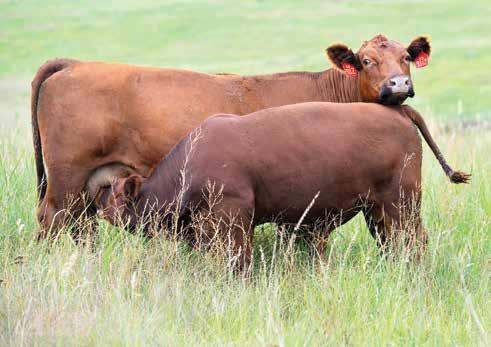



F&R Livestock Resource page 11 Visit www.leachman.com or call (970) 568-3983 to order your catalogs today! Stabilizer Bulls Build Better Cow Herds If you use our bulls, you’ll have more cows that you love. MATERNAL Five-Star All 500 Stabilizer bulls in our Spring Sale will be scored for Maternal Value. Simply use our star system! Leachman Spring Bull & Female Sale March 26-28, 2022 All events will be at the Leachman Bull Barn ▪ Fort Collins, Colo. Saturday, March 26 All cattle available for inspection. Come early, pick your lots. Stay for the sales or bid remotely via one of our Leachman Reps or Superior online. Sunday, March 27 11:30 AM Lunch 1:00 PM 200 Elite Yearling Heifers Sell Angus, Red Angus & Stabilizers 5:00 PM Banquet – Dinner & Entertainment Please RSVP by March 18, 2022. Call (970) 568-3983 today! Monday, March 28 ALL BULLS SELL WITH A BREEDING SEASON GUARANTEE 10:00 AM 500 High $Profit Stabilizer Bulls Sell Lee Leachman, Managing Partner Jerrod Watson, Bull Customer Service (303) 827-1156 Semen Division: 970-444-BULL (2855) Office: (970) 568-3983 • www.leachman.com
says that doesn’t bother him at all.
“I have not regretted it,” he says. “I have paid a couple times and to me, that is a good thing. If I did everything right, and what they bring is more than I insured them for, I am happy to pay it because I made money on the cattle. On to the next one. And the entire time I can sleep at night, because I know I don’t have to go through that panic when the market is down $20 and I own eight or ten loads. That can wreck you for a while.”
Grimes says she rarely hears about a customer who regrets buying the insurance but often hears of ones who wish they’d bought more.
“I have seen some of my customers who look at the program, and if they
can’t lock in a profit, they don’t want to buy the insurance. I don’t think that’s necessarily the best way to look at it. I want to limit the amount of exposure or loss I could have. So even
though I can’t lock in a profit, I still want to limit my downside.”
She adds, “If you want to make money marketing cattle, you want to work this in conjunction with a marketing
program and a marketing advisor to help make those decisions. This is risk management, not marketing, and it’s important for producers to delineate between those two. If they look at it and say, ‘I can’t make money feeding cattle at $1.44, I am going to lose $25 a head at that point,’ then they oftentimes don’t buy the coverage. However, to me, I am thinking, what if it goes even lower, and I am losing more than $25 a head. I don’t want to lose more than I already have exposed.”


Cunningham, too, reminds his clients that he is not a market advisor. “I don’t give any market advice at all, but I will gladly go over some scenarios. After I visit with the customer or potential customer about their program, and when and how they usually sell their calves or cattle, we can explore all their options. I can help provide them with the info they need to determine what fits their scenario the best to limit their risk.”
He adds, “I have done a lot of studying this program and the markets. We’ve sold a lot of LRP insurance, and it works just like it’s designed to work. No one has ever been able to prove me wrong when I say, ‘This is the absolute cheapest way that you can lock in a floor price and leave the topside open.’”
About Joanie Grimes: Joanie Grimes is an agent and partner of ICAP Crop Insurance. She and her partner service policies in Ohio, Nebraska, Missouri, Iowa, Ohio, Kentucky, Indiana, Arkansas and Georgia. They specialize in crop, PRF and livestock insurance. You can reach Joanie at joanie@premiumag.com or 937-393-8800.
About Andy Cunningham: Andy Cunningham and his wife Kodel are insurance agents based in Laverne, Oklahoma, with the AgDefense Risk Management group. In addition to insurance sales they own and operate a commercial cow-calf operation as well as an Angus seedstock herd. They farm dryland and irrigate cropland to produce feed for their cattle. He specializes in LRP and rainfall protection programs. You can reach Andy at andy@ laverneins.com or 580-334-7995.
page 12 Spring 2022
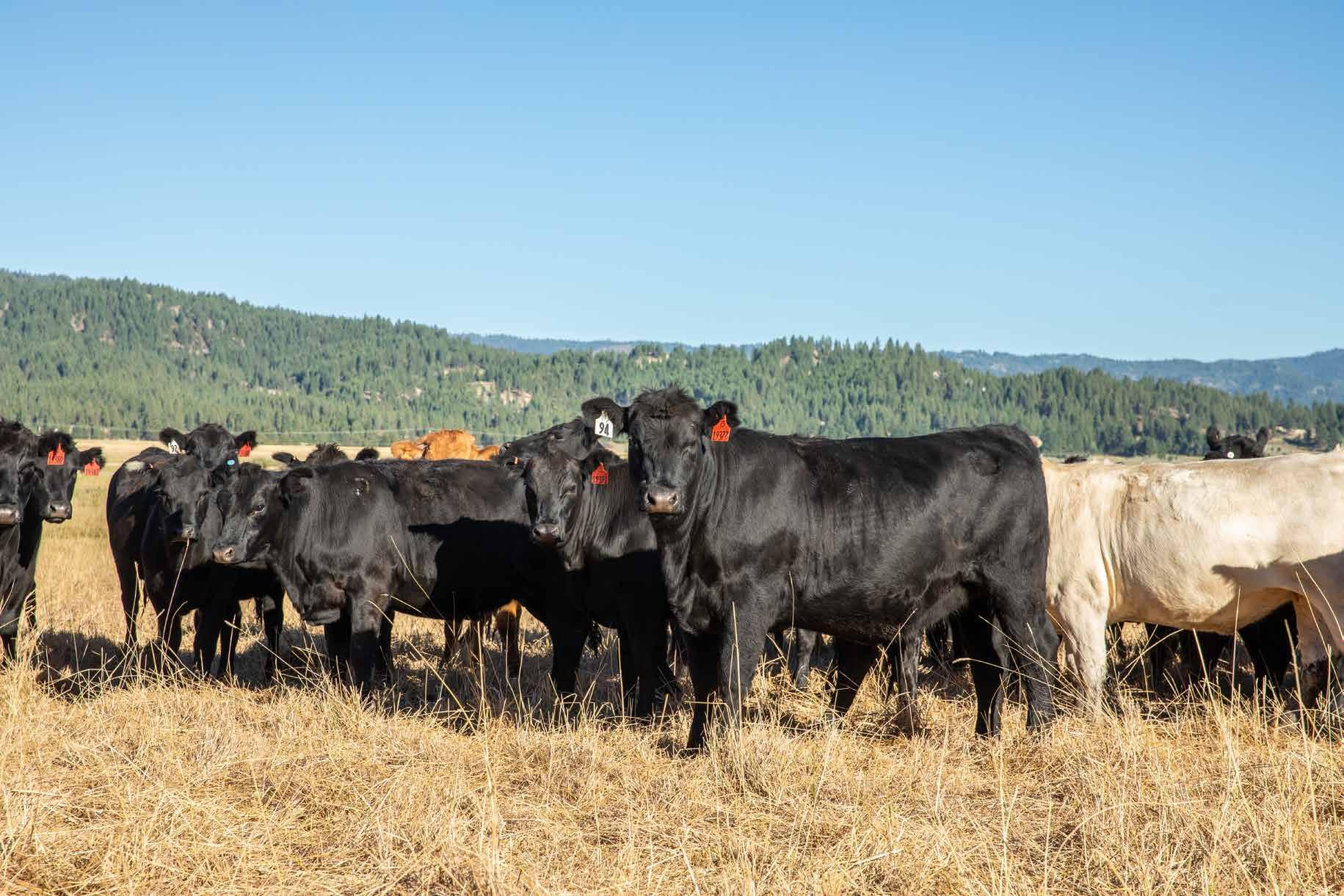

F&R Livestock Resource page 13 Sustainability Credit New programs offer cattle producers the opportunity 800.989.8247 | www.allflexusa.com
controls

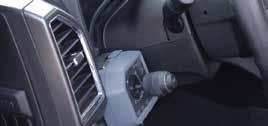
solution to help address the dual challenges of nourishing the population while mitigating climate change.
Last August, the National Cattlemen’s Beef Association (NCBA) released sustainability goals of the U.S. cattle industry, which include demonstrating climate neutrality of U.S. cattle production by 2040.


Net zero is another way of saying climate neutrality. As the name suggests, net zero refers to an industry or source within the industry removing as much carbon dioxide from the atmosphere as it contributes.
In February, EAH announced several new programs aimed at helping its customers reach and document net zero GHG.

For example, EAH is piloting UpLook™, an insights engine based on more than 20 years of knowledge gained from its Elanco Knowledge Solutions portfolio. UpLook is designed to predict greenhouse gas emissions and identify key drivers of an operation’s carbon footprint, providing producers with a baseline of their current stewardship efforts. According to EAH, UpLook can help cattle feeders better understand their baseline, recognize key drivers of their carbon footprint and determine actionable steps to help move their operation toward improved sustainability
and stewardship.
According to Simmons, EAH believes this established baseline and tracking of progress is the first step to certification and monetization of carbon reduction for producers. Initial pilots of the system are beginning with cattle feeders. Availability is expected in the second quarter.

“We are excited to start to turn our commitments into action,” says Sara Place, PhD, chief sustainability officer at Elanco. “This is the first step in a long-term commitment to learn and collaborate with our customers as we navigate this new frontier of opportunity, while helping to make a significant difference for our world.”
Incidentally, EAH recently invested in Athian, a start-up company with the mission of helping the cattle industry capture and claim carbon credits earned through sustainability efforts where possible, primarily by validating and certifying GHG reductions and carbon capture from services like UpLook. Athian is expected to aggregate data for producers of all sizes and then work to create a carbon credit marketplace to monetize and capture value from sustainability efforts.
Through Athian, according to EAH, farmers and ranchers may have a greater opportunity to keep this value within the food system so that carbon
LIVESTOCK RISK PROTECTION
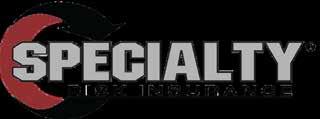
- Contracts are available from 13 weeks to 52 weeks and coverage levels range from 70% to 100%. Producers have the opportunity to take advantage of federal subsidies which range from 35% to 55%, depending on coverage levels. This is a change from previous years where federal subsidy levels were capped at 13%.
- Producers can choose to cover from 1 head up to 6,000 head per sales contract and can cover a maximum of 12,000 head per year. If the actual ending value is below the coverage price, the producer will receive an indemnity payment for the price difference. An example from the January 24th, 2022, market with a 30-week contract ending in August 2022 covering 99% of the board price shown below.


CALL OR CHECK OUR WEBSITE FOR MORE DETAILS www.hydrabeds.com ONLY VARIABLE SPEED WIRELESS CONTROL IN THE BALE BED MARKET PO Box 248 / 902 Hwy 246, Sabetha, KS 66534 800-530-5624
ONLY VARIABLE SPEED ELECTRIC CONTROL IN THE BALE BED MARKET
A new day is dawning with our revolutionary new Hydra STX
In this example, the row of 100 steers shows the producer protected his $76,297 43 Investment by insuring he would receive a minimum of $142,400 at the sale’s closing This insured a gross profit of $61,862 57 or $618 62 per steer LRP can be customized to protect any operation and multiple contracts may be secured throughout the year
more information on Livestock Risk Protection, please call:
The Livestock Risk Protection Plan enables cattle producers to protect themselves against market price declines Essentially, LRP is a tool to insure your equity position if the market drops unexpectedly
For
Brian Youngblood at (417) 825-1203 or Kevin Charleston at (417) 850-5470. -
can customize coverage based on the type of feeder cattle or fed cattle, weights, number of head, sale dates, and expected sale price Feeder cattle prices are based on the Chicago Mercantile Exchange and fed cattle prices are based on the Agricultural Marketing Service
- Producers

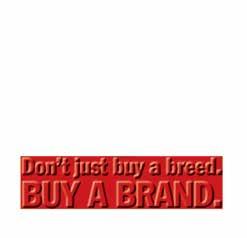

NEW MOON GARDINER ANGUS RANCH SATURDAY, APRIL 2, 2022 n 9 AM HENRY & NAN GARDINER MARKETING CENTER NEAR ASHLAND, KANSAS SELLING APPROXIMATELY 1,050 HEAD, INCLUDING: 400 Registered Bulls n 250 Registered Females n 350 Elite Bred Commercial Females Rising 43 rd Annual Spring Production Sale Certified Angus Beef meat scientists Diana and Daniel Clark will join us Friday evening, April 1, for our presale forum. The program will discover the dollar value difference in an actual GAR USDA Prime steer versus a commodity steer processed the same day. The two primals will be simultaneously broken down into cuts most familiar to food service and consumers, and determine the retail value differences between the two carcasses. Those in attendance will visually experience the Clarks’ presentation to better understand the value of quality throughout the supply chain. Attendees will be encouraged to participate in the quality, value and profitability discussion. The program will illustrate and document the significant value difference in genetic selection for carcass quality, without compromising production or efficiency traits. 1182 CR Y | Ashland, Kansas 67831 | GAR@GardinerAngus.com | www.GardinerAngus.com The Henry & Nan Gardiner Family | Mark (620) 635-5095 Grant (620) 635-0382 | Cole (620) 635-0727 | Ransom (620) 635-0283 Proud to be a founding member of U.S. Premium Beef. More than $11.31 million in premiums and dividends have been paid to GAR customers using USPB delivery rights. Watch the sale and bid live online at LiveAuctions.tv and SuperiorClickToBid.com. Register to bid prior to sale day. GARDINER SERVICE AFTER THE SALE Free Delivery | USPB Delivery Rights | Repeat Buyer Discount | Feedlot Relationships | Marketing Assistance | Revenue Sharing Semen Interest | G3 Age & Source High Accuracy Progeny Proven Genetics | Method Genetics Benchmarking | Genetic Consultation | THE Gardiner Angus Ranch Guarantee
credits do not flow out of the food chain to other industries.
The Road So Far
Heretofore, industry resources revolved around documenting U.S. cattle industry’s contribution to domestic greenhouse emissions overall and as part of U.S. agriculture.
As an example, USDA’s Agricultural Research Service and The Beef Checkoff conducted a comprehensive beef lifecycle assessment, designed to scientifically quantify the sustainability of U.S. beef production. It included collecting and examining feed and cattle production-related data from more than 2,200 cattle producers in seven regional U.S. production areas.


For the record, emissions from cattle, including those that come from the feed production, fuel, and electricity currently account for only 3.7% of the total greenhouse gas emissions in the U.S.
By comparison, globally, beef cattle account for 6% of GHG emissions.
“U.S. beef production, particularly when it comes to GHG emissions, is often misrepresented with global statistics that fuel inaccurate reports and misconceptions,” according to a white paper authored by Place, who preciously served as NCBA’s senior director of sustainable beef production.
“To put U.S. beef production further into perspective, all of agriculture, including beef cattle and other animal and crop agriculture, accounts for 8.4% of U.S. GHG emissions,” according to the white paper. “Comparatively, transportation accounts for 28% of GHG emissions in the U.S. On global scale, all livestock agriculture accounts for 14.5% of GHG emissions, which is often used inaccurately to represent U.S. beef emissions.”
As well, the U.S. Roundtable for Sustainable Beef (USRSB) is a multi-stakeholder initiative developed to advance, support and communicate continuous improvement in sustainability of the U.S. beef value chain.
Think here in terms of things like identifying sustainability indicators,

recognizing verification methodologies and providing a forum for open discussion, information exchange and program development.
USRSB also offers what it terms sustainability modules, a voluntary framework by which stakeholders can self-assess and exploit opportunities for continual sustainability progress. There is a module for cow-calf producers, auction barns, feedlots, packers and processors and retail and food service.


U.S. Cattle and Beef are Sustainability Leaders


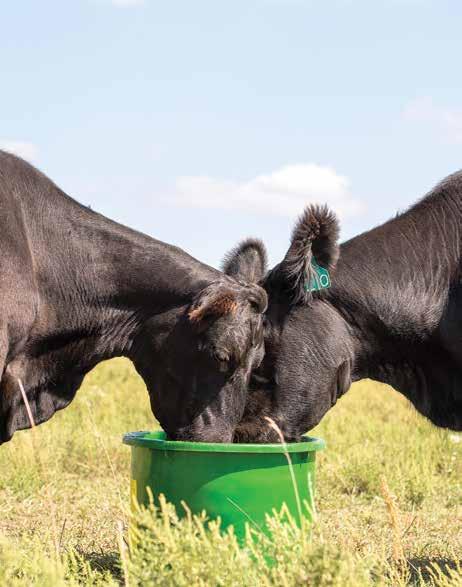
Here’s why cattle producers should be eager rather than reluctant to embrace the sustainability conversation—agriculture and beef cattle win.
“Agriculture and forestry are the only two sectors that don’t just produce these greenhouses gasses as a source, but they are also a sink for them because plants and soils take carbon out of the air and store it,” explains Frank Mitloehner, a noted air quality specialist in the University of California-Davis department of animal sciences. He is also founder and director of the school’s pioneering CLEAR Center – Clarity and Leadership for Environmental Awareness and Research.
Mitloehner’s comments come from last fall’s Henry C. Gardiner Global Food Systems lecture at Kansas State University (www.K-State.edu/Research/Global-Food/Events/Lecture-Series/).
He focused on methane, which he explained matters the most when it comes to GHG and animal agriculture.
In simple terms, Mitloehner explained some GHGs, such as carbon dioxide are known as stock gases because they are cumulative each time they are emitted into the atmosphere, such as every time you drive your car to work.
Methane, on the other hand, is what’s known as a flow gas. An equal amount of what is emitted into the atmosphere is also destroyed via
page 16 Spring 2022 KattleEnergy products are formulated to match the diverse nutritional requirements of a cow herd and available forage resources. Highly digestible distillers grains are used in high fat, 30% protein, all natural, free choice tubs, cubes and pellets in a nutritional combination designed for optimal performance. 50 lb. Bags and 2,000 lb. Totes Cubes & Pellets PERFECT PASTURE PERFORMANCE n Self limiting n Higher nutritional profile than molasses n Highly digestible distillers grains n High fat Tubs KE Feeds • (620) 727-5197 1630 Avenue Q • Lyons, KS 67554 Sales@KEFeeds.com KEFeeds.com
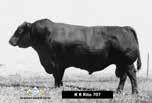

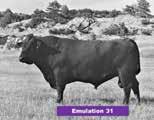
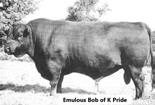
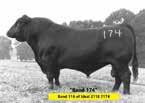
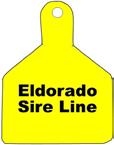

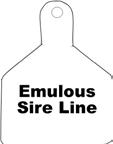
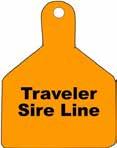
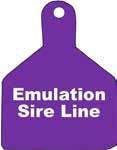





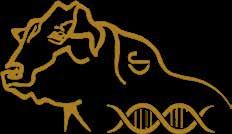
F r o m A m e r i c a ’ s # 1 C h o i c e f o r B u l l s A t t h e f a r m i n I d e a l , S D Selling 175 Re gister ed Angus Bulls Fr om the Her d Backed by Seven Gener ations of Selection and Powered by the Mother lodeTM F o r a S a l e B o o k o r M o r e I n f o r m a t i o n Call us at 8 0 0 - 5 4 8 - 2 8 5 5 or d a v i d @ j o r g e n s e n f a r m s . c o m Jorgensen Land & Cattle • 31250 265th Street • Ideal, SD 57541
natural chemical reaction.










“So, a constant source of methane from livestock, from a constant herd, does not produce new and additional carbon into the atmosphere (from methane). Hence, it does not produce new, additional global warming…We are cycling carbon through the atmosphere to our pastures, through the animals and back into the atmosphere.”

Consequently, when it comes to methane, beef cattle are part of the solution.



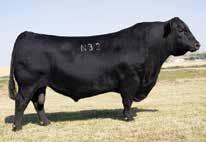


















“People in agriculture are really good at what they do, but we are not good communicators overall,” Mitloehner said. “As a result, people who are critical of modern agriculture have stepped out and used their megaphone to critique agriculture and the practices we use today.
“To me, it’s not just important to do research and to teach, but also to extend that knowledge. The entire agriculture industry needs to do a better job of communicating what we do and how we do it in a sustainable way.”
page 18 Spring 2022 Vermilion Ranch Pat Goggins Family Bob Cook - Records & Sales Cell: 406-670-0078 Je Mosher - Vermilion North Brandon Mosher - Pryor Creek Jake Kading - Herdsman Cell: 406-672-5844 Bill Shaules - South Pryor Greg Roberts - Diamond Ring PO Box 30758 Billings, MT 59107 Email: bcook@cattleplus.com www.vermilionangus.com Vermilion Ranch Sale broadcast and videos available online through Northern Livestock Video Auction www.northernlivestockvideo.com THURSDAY, MARCH 24, 2022 Heifers sell at South Pryor Development Center, Billings, MT - 12:00 FRIDAY, MARCH 25, 2022 Bulls sell at Public Auction Yard, Billings, MT - 11:00 Spring Performance Sale 500 TOTAL PERFORMANCE YEARLING ANGUS BULLS 5,000 FANCY OPEN COMMERCIAL REPLACEMENT ANGUS HEIFERS All One Iron - Bangs Vaccinated - Ready to Breed - Montana’s Best No where in America will you find this quality and quantity in one place! 5,500 ANGUS SELL Vermilion Ranch Vermilion Ranch Casino Bomber N33 100 sons and grandsons sell. Follow Us Dick & Shelly Ben, Anisha, Elliott & Sophie Dustin, Elizabeth, Cassie, Billy, Annabelle & Jane Calving Ease Carcass $Values EST 1932 Monday April 4, 2022 1:00 pm 2335 10th Rd Lorraine, KS 67459 www.greengardenangus.com janssen@greengardenangus.com Green Garden Angus Selling 90 Registered Angus Bulls Featuring: Heifer Pick of the Herd C Average EPDs EPD Bull Average % of the Breed CED 9 30% Birth .7 20% DMI .51 20% Marb 1.48 1% $G 85 1% $B 171 10% $C 289 10% elebrating 90 Years
Clear Sailing Markets poised for extended run higher.
 By Wes Ishmael
By Wes Ishmael
Set aside current and expanding drought. Ignore notions of another black swan event. Supply and demand fundamentals point to higher cattle prices for at least the next couple of years.
Plenty of that has to do with fewer cattle numbers from the nation’s contracting beef cow herd.
Beef cows of 30.125 million head Jan. 1 were 718,500 head fewer (-2.3%) than the same time last year, according to USDA’s Cattle report. That is the fewest number since 2015 and was the largest year-over-year decline since 1996-97, according to David Anderson, Extension livestock economist at Texas A&M University. He adds the report included a significant revision of 314,000 fewer head in the previous year’s beef cow inventory.
Although drought contributed to the decline in beef cows, Anderson adds calf prices, relative to costs, also has forced some culling.
Beef heifers held for replacement of 5.611 million head were 191,600 head fewer (-3.3%) than the previous year.

“That is the fewest replacement heifers held back since Jan. 1, 2014,” Anderson says, in a recent issue of In the Cattle Markets. “While fewer replacements would be needed with a smaller cow herd, a reduction this large indicates some expectations of more herd contraction.”
The calculated feeder supply outside of feedlots of 25.537 million head was 676,000 head fewer (-2.6%) than last year.
Dairy cows of 9.375 million head were 67,400 head fewer (-0.7%)
All cattle and calves of 91.902 million head were 1.888 million head fewer (-2.0%).
“The inventory report indicates that we are headed towards less beef production and higher prices,” Anderson says. “A cow herd of this size should also lead to some expectations of calf prices approaching the rarified air of the years following the Texas 20102012 drought. The current drought and its development over the coming months will dictate a lot about the cow herd over this year. But, good beef demand should also pull prices higher on top of available supplies.”
USDA’s Economic Research Service (ERS) projects beef production this year to be 27.4 billion lbs., in the February World Agricultural Supply and Demand Estimates (WASDE). The total would be 562 million lbs.

less (-2.0.%) than last year.
“The beef production forecast is raised from the previous month as larger expected placements during first-half 2022 are marketed in the latter half of the year,” explain ERS analysts. “However, the increase in fed cattle slaughter is partly offset by lower non-fed cattle slaughter.”
Total red meat and poultry production this year is forecast to be 106.6 billion lbs., which would be 183 million lbs. less than last year (-0.2%).
F&R Livestock Resource page 19 RANCHES Trust... the most important selection tool! We measure and select for the traits that impact cow herd efficiency: Calving Interval, Docility Scores, Structural Soundness, Feed Efficiency, Calving Ease and Cow weights and Body Condition Scores. You can Trust your cow herd to Mushrush Red Angus! Annual Production Sale Friday, March 18, 2022 • 12:30 pm CT 100 - Age-Advantaged, Feed Efficiency Tested Red Angus Bulls 100 - Stout Yearling Bulls (Red Angus & SimAngus) 50 - Fall calving Commercial bred Red Angus females 12 - “U Pick Em” Front-end Registered Red Angus Open Heifers 2346B N Road ∙ Strong City, KS 66869 620.340.7461 (Joe) 620.340.9774 (Daniel) info@mushrushranches.com MushrushRanches.com Follow us on FB at Mushrush Red Angus
Cattle Prices Head Higher

In the latest WASDE, ERS projected the annual average five-area direct fed steer price for this year at $137.50/ cwt. Prices are projected at $139 in the first quarter, $136 in the second quarter, $135 in the third quarter and $140 in the fourth quarter.
CattleFax was even more bullish in its Outlook Seminar in Houston the first week of February.
With cattle numbers declining, front-end fed cattle marketing approaching pre-covid levels and beef demand continuing strong, CattleFax projects the average fed steer price this year $18 higher year-over-year at $140/cwt. with a range of $130-$155. The organization forecasts the average feeder steer price (800 lbs.) at $172 with a range of $158-$184, and the average calf price (550 lbs.) at $205 with a range of $180-$230.
Moreover, CattleFax forecasts utility cows at an average of $75/ cwt. with a range of $65 to $85. Bred cows are expected to bring an average $1,850/head with a range of $1,700 to $2,000 for load lots of quality, running-age cows.

The feeder cattle and calf supply will be 675,000 head fewer than last year, totaling 25.5 million head, according to CattleFax. Fed cattle


slaughter will decline 400,000 head to 25.7 million head. Commercial beef production will contract over the next several years starting with a 2% decline in 2022.
Kevin Good, CattleFax vice president of industry relations and analysis, pointed out U.S. beef cow inventories declined more than 700,000 head last year and are nearly 1.6 million less than the cyclical peak.
“Drought, market volatility and processing capacity challenges affected 30-40% of the cow herd over the last year. Without an improvement in weather and profitability, at least 250,000 more head will be liquidated in 2022,” Good says.
Wholesale beef demand will likely slow in the coming year, but cutout value should hold steady near an average of $280/cwt., according to Good.
Good explained global protein demand continues to rise, and U.S. beef exports are expected to grow by 5% this year to 3.7 billion lbs., supported in part by tightening global protein supplies.
Beef export volume was record-large last year at 1.44 million metric tons, according to data released by USDA and compiled by the U.S. Meat Export Federation. Volume was 15% more than the previous year and 7% more than the prior record set
Rawhide Processor

• Pull on highway at speed limit.
• Fits through any gate your pickup will.
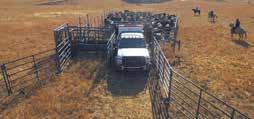
• Stable on uneven terrain.
• Wheels on each panel and electric over hydraulic jack eliminates lifting— saves time.
• Frame gates for sorting.
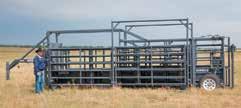
• Transport wheels are permanent, no sliding off the axles and rolling out of the way.
• Permanent sheeted adjustable alley.

page 20 Spring 2022 The First Hydraulic Corral and still the Largest!
Rawhide Portable Corral 900 NORTH WASHINGTON ST., ABILENE, KS 67410 785.263.3436 www.rawhideportablecorral.com 3 Sizes Available!
by John McDonald
Circle S Ranch John & Carla Shearer & Family • Canton, Kansas Home 620-628-4621 John Cell 620-654-6507 • Johnny Cell 620-654-6731 Email: circle_s@hometelco.net www.circlesgelbvieh.com 15th AnniversaryCircle S Ranch Production Saale __________________ Saturday, April 2, 2022 1:00 p.m. CST • Canton, KS Offering....70 fall & yearling bulls 10 Gelbvieh show heifers 30 pens of Gelbvieh, Gelford and Gelbvieh influenced open heifers Fall Gelbvieh/Gelbvieh influenced bred heifers First calf Gelbvieh & commercial Gelbvieh influenced heifer pairs 2022 Cattlemen’s Congress Champion Pen of Three Gelbvieh Bulls These bulls sell in our upcoming production sale!
in 2018. Export value last year was 38% more than the previous year and record-large at $10.58 billion. Beef export value per head of fed slaughter equated to a record $407.22 in 2021, up 35% from a year earlier.
Likewise, CattleFax sees continued domestic consumer beef demand strength this year.
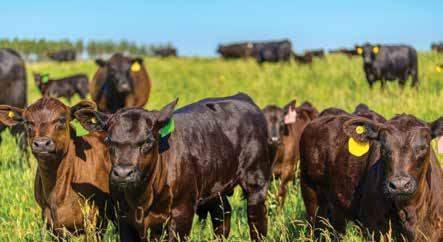
Good explained inflation is also driving beef prices to a higher trading range. The USDA All-Fresh Beef Retail Price should average near $7.15/lb. this year, ultimately resulting in more margin in the system.
While U.S. median household income increased last year, historically high inflation is affecting low-to-middle income Americans the most, Good says.
Wild Cards, As Usual
OK, now consider the drought.
The first week of February, 72.2% of the nation was either abnormally dry or in some stage of drought, according to the U.S. Drought Monitor. That was 7.8% more than the same time a year earlier; 9.5% more was experiencing moderate to exceptional drought.
La Niña remains firmly in control of the ocean-atmosphere system, and that is unlikely to change this spring, said meteorologist Matt Makens, during the CattleFax Outlook.
Barring any change to the La Niña outlook or sudden warming in the Gulf of Alaska, Makens explained that likely means dryness continues across the Southwest and South with warm temperatures. The Northern Plains and Corn Belt are expected to have wetness farther east this spring and drier conditions for this summer, with temperatures closer to normal versus last year.
“There is plenty of time to avoid widespread drought impacts but without significant moisture in the next two to three months, the cattle industry could see major market impacts that affect the entire industry, as well as the tremendous hardships that would land on many producers and individual operations,” explained Derrell Peel, Extension livestock marketing specialist at Oklahoma State University, in January market comments. “Although the worst impacts may not be realized for several months yet, producers should begin planning now for the decisions that would be required if spring doesn’t come. Hopefully it is a plan that will never be needed.”
The season-average corn farm price for 2021-22 is projected at $5.45/bu., in the latest WASDE.

“Exceptional demand from China is leading U.S. corn exports to new records and expanded interest could easily push exports higher in 2022,” according to Mike Murphy, CattleFax
vice president of research and risk management services.


Murphy noted that weather is likely to continue influencing hay prices with much of the Central Plains and the West battling some level of dryness
or drought. He explained, on-farm hay stocks Dec. 1 were 6% less year over year at 79 million tons.
“Expect current-year hay prices to average near $186/ton, $10 higher than 2021 prices due to tighter supplies and
stronger demand,” Murphy said.
Political Risk Remains Front and Center

Depending on your leanings, cattle markets dodged a bullet recently when
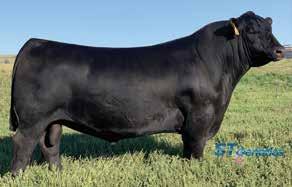
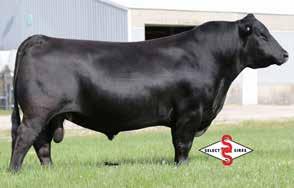




F&R Livestock Resource page 21
T Seven Ranch Jerry & Mike Gilliam (785) 452-1548 ~ Jerry (785) 747-6969 ~ Mike G&G Angus T. Brad Gilliam (785) 747-7580 ~ cell (316) 734-4869 ~ Aaron Doll For catalog or information, contact: • All bulls performance tested • Strict breeding soundness exam • Stacked, predictable, proven pedigrees “75 Years of A.I. Represented in These Two Programs” Cattlemen, calves sired by these bulls typically bring $2-$5/100 lb. more at sale time. Reasonably Priced! Bulls that really produce! “Best Genetic Value Anywhere!” Pictures, video and on-line catalog available at www.tsevenranch.wordpress.com Angus: Raindance ~ Blueprint ~ Playbook ~ Bonanza ~ Growth Fund Gold Rush ~ Payweight Simmental: Cowboy Cut ~ Exclusive Gold Rush Sires represented: No ultrasound, no sorting ... just the bottom ½ of our calf crop! Blueprint SCALE HOUSE AND SHRINK SYSTEM TYSON FRESH MEATS, FINNEY COUNTY RUN DATE: 05/26/20 68% Prime 26% CAB 6% Choice 100% = $15,778.27 in premiums CATTLEMAN’S CHOICE SALE & Customer Appreciation Celebration! SATURDAY MARCH 19, 2022 SALE 5:00 P.M. Sale followed by meal and entertainment by Nashville recording artist Jason Callahan! Raindance QUALITY GRADING PRIME 75.0 CAB 28.0 CHOICE 7.0 SELECT 0.0 HEIFERETTE 0.0 NOROLL 0.0 OTHER 0.0 TOTAL 110 T Seven Ranch Sale Facility • GREENLEAF, KS • 2211 15th Road ~ 2020 T Seven Ranch home-raised fed cattle ~ 55 Angus & SimAngus Bulls ~ 18 months old ~ 7 two-year-old ET Bulls Sired by Woodmill Blueprint out of T Seven donors Special Feature
The Quality We Breed
Castration

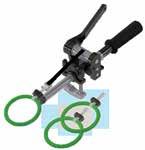

members of the National Cattlemen’s Beef Association reaffirmed their opposition to mandated cash fed cattle trade, and members of the U.S. Farm Bureau Federation changed policy to oppose mandated trade. There’s no telling what Congress will do with current bills in various stages of progress that ask for mandates.


For instance, the Cattle Price Discovery and Transparency Act (CPDTA), was introduced in March last year and then subsequently re-introduced in the U.S. House and Senate last fall.


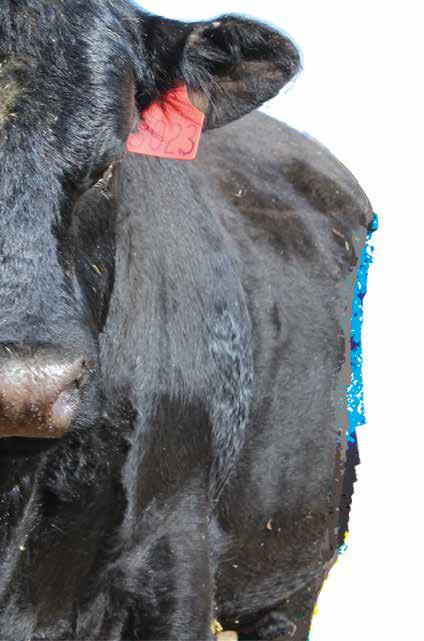
Among other things, the bill calls for mandated levels of regional cash fed cattle trade.
According to a recent analysis by the Fryar Price Risk Management Center of Excellence at the University of Arkansas the bill’s trade mandate could hinder pricing innovations that have contributed to beef demand growth over the last 20 years and translate into lower prices for cattle producers.
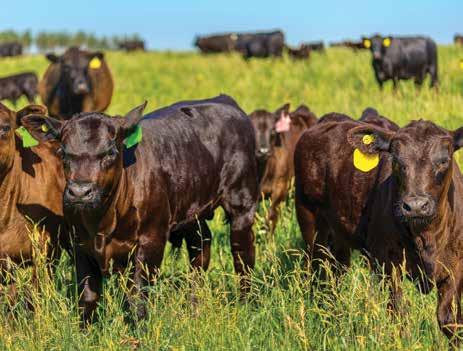

Cash cattle trade lessened over time as cattle feeders and packers increased the use of alternative marketing agreements (AMAs), which enable further differentiation and value segregation of beef carcasses. AMAs enable paying more for cattle that produce beef of higher value to the consumer—clearer pricing signals. At the same time, AMA participants reduce transaction costs and price risk.
For comparison, the analysis explains negotiated cash fed cattle trade usually revolves around a single price
paid for all cattle in a pen. That means the average price discounts cattle of higher value and rewards cattle below the pen average.
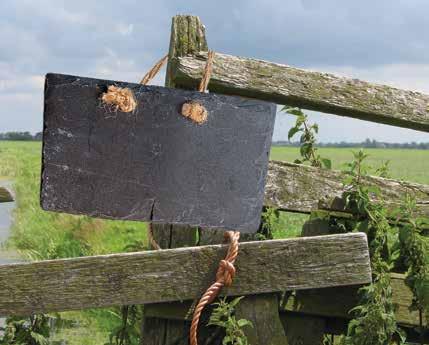
“By privileging an average pricing system in the sector, the legislation makes it less likely that innovations such as AMAs will be pursued. Innovations that might further reduce transactions costs and/or support further production changes to more closely align the beef end product with consumer tastes and preferences could be beneficial to maintaining and even growing beef demand in the future,” says John Anderson, director of the Fryar Price Risk Management Center of Excellence. He coauthored the analysis report.
“If AMA use in the Southern Plains is restricted, the most likely immediate outcome is that transaction costs … between feeders and packers will likely go up,” Anderson says. “The lion’s share of this increase will most likely be borne by cow/calf and stocker producers in the form of lower feeder cattle prices.”

The CPDTA includes other elements widely supported by cattle producers, such as increasing the level of price reporting.

“We support the majority of this legislation (CPDTA), but we cannot support mandatory cash sales,” says AFBF President Zippy Duvall. “We are committed to working with the sponsors of the bill to make revisions
ensure it aligns with the priorities outlined by our membership.”
page 22 Spring 2022 CallicrateBanders.com Made In USA COMPRESSION ANALGESIA
made easy! ™ Tensioned Loop for Newborns Built-in Cutter Self-locking Loop Since 1991 785-332-3344
to
Reference Sire: Sydgen Enhance, Basin Payweight, In focus
It’s not easy. Significant progeny genetic value is important. We have to look for reasonable caving ease, top end growth, efficiency, disposition, soundness, fertility and convenience traits. We are proud of our high fertility females and do our best to use proven multi-trait superior AI Sires. It takes time and resources to build the good progeny into a herd, we’ve done our best. Come see what we’ve done. We think you will be impressed with the quality we’ve bred. PRIVATE TREATY ANGUS, SALERS and OPTIMIZERS CATTLE FOR SALE At The Ranch. The Katzenmeier Family • Ellsworth, KS Facebook.com/Katzenmeiercattleco D. R. Katzenmeier, 785-643-8656 / Kayla (Katzenmeier) Errebo, 785-420-0304 Mill Brae IF Joanie 0025 SydGen Enhance
Reference Dam Sires: Breaking News, Whitlock,
Cowboy Up,
Renown, Niagara, Confidence
Plus, Payweight
Tax Flattener
By Wes Ishmael
Hooter McCormick was the only client that Wylie Zimmerman had ever fired. He’d done Hooter’s tax work for years, or attempted to, but there came a day three years back when his constitution balked at the thought of one more go-round with Hooter’s logic-defying approach to the tax system, not to mention the constant calls from the IRS and subsequent audits on Hooter’s behalf.
“My business has grown in other directions, so it is with great regret…” is what he’d told Hooter. “No, I’m sorry, I have no one to recommend to you…”
Although professional to the core, Wylie was so happy to shed his client that he’d driven to Apache Flats to drop Hooter’s records at his feet, then he caught the first plane to Vegas for a celebration.
As it so often happens in business, Wylie’s replacement turned out to be the friend of a friend of a friend who ended up being a closer pal than those connecting the two.
Fact is Boudreaux “Buddy” Babineau III and Hooter were among the few the two had ever met who saw the world similarly. Heavens, Buddy even understood how it was that the untimely death of Hooter’s diving pig some years earlier was a legitimate business expense. As such, after a short interview in his Lubbock office, Buddy was tickled pink to take Hooter on as a client. Truth was, Buddy didn’t have any other clients, nor did he need them. A series of successful oil and gas deals meant Buddy never had to hire out his legal and accounting expertise ever again. But, he liked Hooter, plus he hated the tax system.


Ever since taking Hooter on, Buddy had fended off requests for another audit through the use of his wit, charm, experience and some legal maneuvering that would have made F. Lee Bailey proud. He answered every urgent call from Hooter about another threatening letter with the same calm, “Not to worry, they can’t do that.”
Now, more than ever Hooter was glad he’d had to find another taxman.

“Blood suckers!” shouted Hooter as he crumpled up the letter and aimed it toward the trashcan. “Blood suckers,” he growled as he dialed the numbers to Buddy’s office.
“They claim they’re going to seize my assets and take control of my accounts!” shrieked Hooter into the phone.
“Not to worry, Hooter. They can’t do that,” came Buddy’s soothing voice.
“As I say, there’s nothing to worry about. In the name of sport, however, and as a courtesy to them, of
course, might I recommend that we invite them for a visit? I’ve no doubt the Insidious Revenue Suckers have overestimated your tax liability. In fact, I wouldn’t be surprised if they owe you money. Do you have the name and
number of the agent? I’ll have Delia arrange it.”
First Steps to Nowhere
So it was that Hooter sat in Buddy’s office awaiting the arrival of agent
A STEP AHEAD
THE ADVANTAGE
YOU CAN TRUST
F&R Livestock Resource page 23
Humor GENEPLUS GENEPLUS
“I appreciate that, Buddy, and you’ve been right all along, but they never threatened this before.”
Hunter Smithton. Buddy was happily puffing on his ever-present pipe. He patted a pile of folders on the corner of his desk that had to be at least a foot thick. “Yes sir, Hooter, it just doesn’t get any better than this. Leave it to me and enjoy.”
Hooter wanted to do just that, but he wasn’t sure how he was going to get out of the mess he was in, or even what kind of mess it actually was. Who could understand all those forms and accounting terms to start with? Hooter wasn’t heartened by the appearance of agent Smithton: about 6 ft. 4 in., shaved head, built like a linebacker.
Buddy just grinned from ear-to-ear before blowing a cloud of pipe smoke into the agent’s face as he took him by the arm.



“I’ve taken the liberty of setting up


a work station for us,” said Buddy leading the agent and his client through a giant oak door. “I call it the war room.”
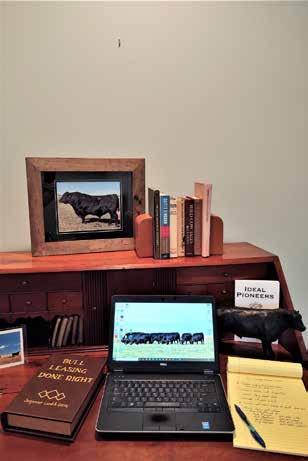
Indeed. Hooter guessed the room had to be at least 1,200 square feet. There were boxes upon boxes bursting at the seams scattered all around. Several computers winked and whirred along the right-hand wall. At the front of the room was a gargantuan blackboard, made more white than black with the scribble of dense and endless mathematical equations.
“Actually,” said Buddy. “I should really call this the Hooter McCormick hall. All of this is in response to your little request.”

The agent glared, then he forced a smile. “I appreciate a sense of humor as much as anyone else, but I know Mr. McCormick’s tax returns and




page 24 Spring 2022
u l l L e a s i n g D
i g
A m e r i c a ’s # 1 C h o i c e f o r B u l l L e a s i n g 8 0 0 - 5 4 8 - 2 8 5 5 d a v i d @ j o r g e n s e n f a r m s . c o m
7-decades of genetic selection are bred into the bulls you get from Jorgensen Land & Cattle.
S i r e L i n e s o f S i g n i f i c a n c e # 1 o n B E E F S e e d s t o c k 1 0 0
B
o n e R
h t
Over
Our
goal is to provide you with bulls that will help you build & maintain a fault-free performance cow herd.
corresponding records couldn’t come to all of this.”
“Au contraire, Mr. Smithton,” said Buddy with a grand flourish. “Have a seat. All of this is in response to your organization’s harassment of my client.”

Smithton stiffened at the challenge. “Well first, we are not harassing any…” “There, there agent, there will be plenty of time for denials. Like you, we are busy men, so let’s get to it, shall we? In your letter you threaten to seize my client’s assets. Rather than getting into the illegalities of such a preposterous notion, I took it upon myself to do some research.” With that, Buddy hoisted the foot-thick bundle of folders onto the table.
“But,” began Smithton. Buddy cut him off again. “Now, it’s not polite to interrupt, you should know that by now. This folder contains a summary of the entire affair, including miscalculations by your agency, credits unclaimed by my client and so on. The crux of it is that rather than my client owing you anything, the government in fact owes my client $17, 814.31, plus interest, I might add. As a gesture of good faith my client is willing to forgo the interest due if this matter can be settled today.”
“Now, see here,” tried Smithton again.
“Indeed, interrupting is the sign of a weak character, Mr. Smithton. “Perhaps that is what led to your little, shall we say, lapse of judgment in 1993.” Buddy plucked another folder from the table.
“Ah yes, here we are. One charge of public intoxication, one charge of obstructing justice. Hmmm… and the latter charge occurred first, now that is an interesting approach to mayhem.”
Smithton looked exactly like a snowman feeling the first warm waves of a Chinook win. “I don’t think…”
“Oh dear,” continued Buddy, wrinkling his brow in concentration, “Then there’s this little indiscretion in 1998, which really isn’t so little, is it? Well, thankfully no one was hurt.”
Hooter had melted into an overstuffed chair. Whether Buddy was getting him in deeper or pulling him out, he couldn’t tell, but he was sure enjoying the show.
Smithton pounded his fist on the table, towered over Buddy and seethed in an incoherent rage: “How? You have no right…doesn’t have anything to do with the matter…it’s against the law… I’ll see you swing…”
Buddy simply blew another puff of smoke into the agent’s face and pushed him into a chair.
“Aren’t IRS records handy tools for tracking down information about individuals, Mr. Smithton? My background search would have taken much longer without them.
Now that we know more of each other—much more about you than I would have ever liked to—let’s get on with the business at hand. You are threatening to seize my client’s assets for not paying back taxes. But as you can plainly see in the summary I’ve provided you, Mr. McCormick doesn’t owe you anything, so the only question is when he can expect a check from you.”
Knowing When to Say Win

Though visibly shaken, Smithton was fighting hard to keep up the bluff. “You’re not the only one with a calculator, friend. I’ve been over the case with a fine-tooth comb, and your client owes us $8,123.27, including

Editor’s message continued

Continued from page 3
from 2020. Beef exports to Mexico are continuing to rebound and increased 4% from 2020, while the value increased 24%. Central America set new records. Exports to Columbia doubled in 2021.
Exports accounted for 15% of total beef production and 12.8% for muscle cuts. In other words, extraordinary value is added by exporting portions of the carcass that have less
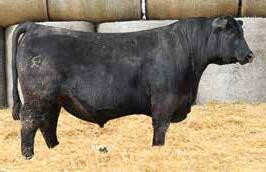

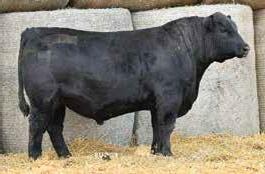

appeal and less value to American consumers.
Back to the memes. The best part of social media is the DELETE and HIDE options! I temporarily feel better. But my option to ignore is not a fix for the absence of critical thinkers. My respect for progressive, engaged and forward-thinking beef industry stakeholders simply gets stronger every day.
Age or Social Media Exhaustion!
F&R Livestock Resource page 25 For more information about our program, please contact: Darrell & Frina Kaiser 6051 Co. Rd. X Park, KS 67751 Home (785) 754-2334 Mobile (785) 673-3357 dfkaiser@ruraltel.net www.KaiserAngus.com Kaiser Angus EPD % CED 9 30% BW 1.7 60% WW 79 10% YW 149 3% Doc 13 75% Marb 1.08 10% RE 0.71 35% $M 38 95% $W 84 10% $B 189 3% $C 283 15% KA West Point 0109 9/20/20 20238027 Sire: EWA West Point 7258 MGS: Baldridge Command C036 HE SELLS 22nd AnnuAl Production SAle thurSdAy, APril 7, 2022 At the rAnch neAr PArk, kS Time-Tested kAiSer GeneticS SellinG: . 110 18-Month-old & yeArlinG BullS . 10 reGiStered yeArlinG et heiferS SELLING SONS & DAUGHTERS SIRED BY: 44 Bragging Rights 4372 EWA West Point 7258 E&B Plus One GB Fireball Tehama Tahoe Deer Valley Foxtrot GAR Xceptional GAR Phoenix GAR Ashland 804M EPD % CED 9 30% BW 3.0 85% WW 79 10% YW 138 10% Doc 15 65% Marb 1.06 10% RE 0.91 15% $M 80 10% $W 79 15% $B 178 10% $C 311 3% KA sunbeAm W0317 9/14/20 19964816 Sire: GAR Sunbeam MGS: Woodside Rito 4P26 of 0242 HE SELLS EPD % CED 9 30% BW 1.6 60% WW 74 15% YW 133 15% Doc 26 15% Marb 1.06 10% RE 0.76 30% $M 88 3% $W 85 10% $B 155 25% $C 289 10% KA Plus one W0318 9/23/20 20041079 Sire: E&B Plus One MGS: GAR Sure Fire HE SELLS EPD % CED 4 70% BW 2.2 75% WW 108 1% YW 181 1% Doc 25 20% Marb 0.85 25% RE 1.30 1% $M 85 5% $W 121 1% $B 191 3% $C 333 1% KA tAhoe W0325 9/07/20 19962927 Sire: Tehama Tahoe B767 MGS: GAR Method HE SELLS
Old
interest, and has owed portions of it for going on five years.”
That brought Hooter back into the game. “You blood-sucking, time-stealing…”
“I think what my client is trying to say,” interjected Buddy, “Is that you have a lot of nerve to fallaciously accuse and harass him when your agency is at fault. If you persist in this manner we’ll have no choice but to file suit to that effect.”
“File suit!” shouted Smithton, hammering the table with oversized mitt again. “What would you have to file suit over? All I’m trying to do is get this deadbeat to pay what he owes.”
Hooter was halfway across the table with justifiable homicide in mind, but Buddy caught him by the belt and pulled him back across.
“There, there, Mr. McCormick, I don’t blame you a bit, and yes, we will add assault to the charges against this societal blight,” soothed Buddy. Before the agent had a chance, Buddy turned on him.
“What he owes. That is an interesting proposition. What my client owes who and for what? Certainly it can’t be that you think he’s not paying his share. Last I looked, according to the tax foundation individuals and couples with an adjusted gross income of $28,000 or more are paying 96% of all of the
federal income taxes collected. You do realize that almost a third of the nation’s tax payers, primarily those making less than that amount, not only don’t pay any taxes but get refunds!”
“But…”
“Furthermore, you’re certainly aware that the cost to taxpayers of complying with the tax code, in addition to the tax itself, is the equivalent of about 20 cents for every dollar of tax collected.”
“But…”
“So, you increase the taxes and the cost of complying with them for individuals and for small businesses like that owned by my client, business people who provide jobs for others and are willing to take risk, even while you rob them of the incentive to take that risk, then you have the audacity to talk about what they owe?”
“But…”
“No, I’m sorry agent Smithton. My client has grown weary of this harassment for extraordinary extortion,” continued Buddy.
“I’ll…I’ll…”
“You’ll what, ask me to dance?” smiled Buddy, taking a photo from the file folder. “I dare say that must have been a legendary office party. Isn’t cross-dressing illegal anywhere?”
The last Buddy and Hooter saw, Smithton was running out the door like his life depended on it.
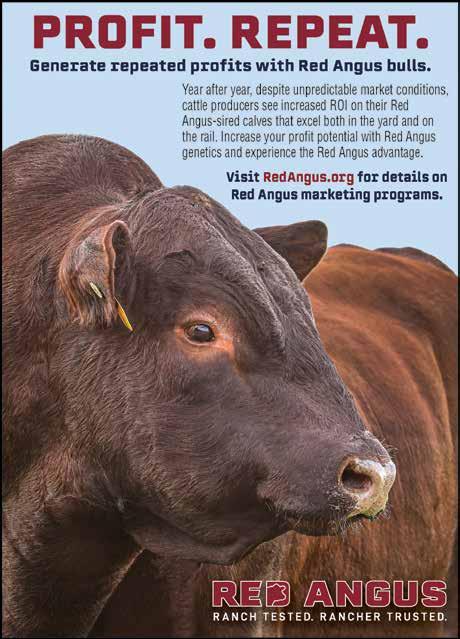
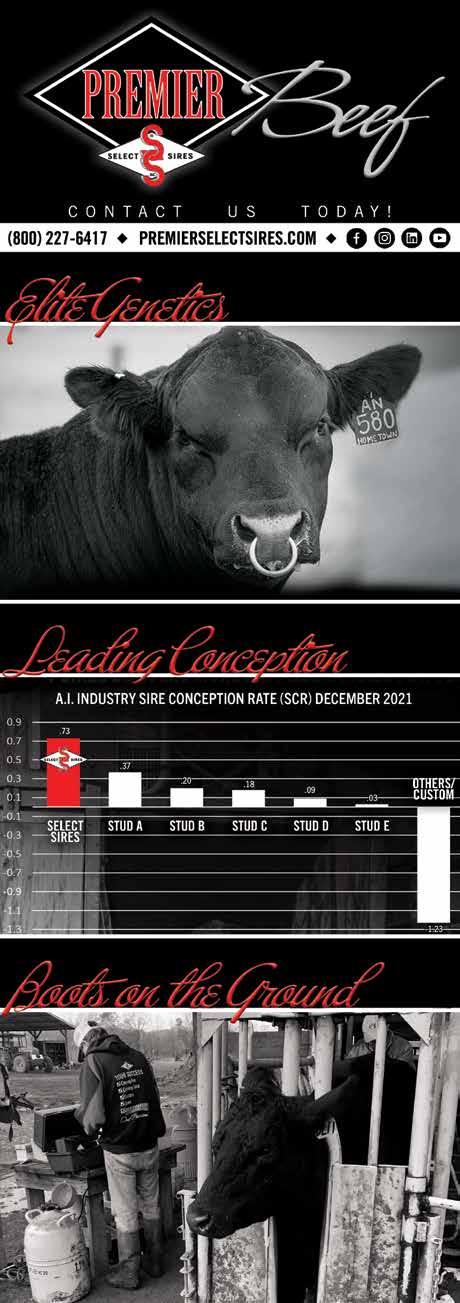
page 26 Spring 2022
ELANCO INSECTICIDE EAR TAGS PROVIDE EXTENDED CONTROL OF COSTLY FLIES.
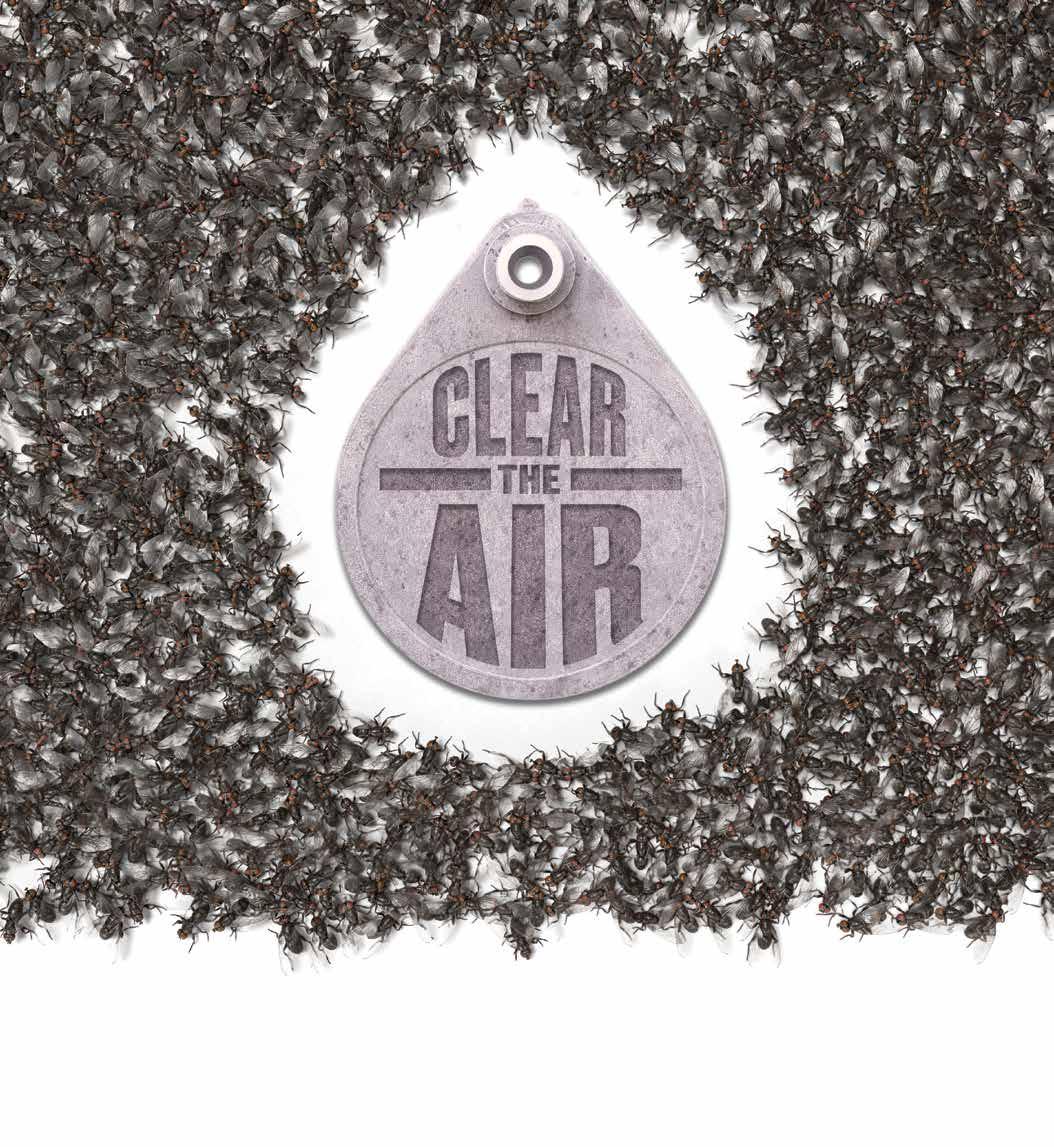
Managing nuisance flies is easier and more cost effective than hoping they’ll just go away. Elanco insecticide ear tags offer lasting, proactive protection of your cattle and your bottom line. Studies have shown an investment of just $6 per animal for insecticide ear tags can result in a weight gain of more than a pound per week when flies are controlled. That gain means ear tags can pay for themselves in the first 60 days of use.* 1,2,3 Ask your local retailer about Elanco ear tags today or find more details at ElancoFlyControl.com. *For
² Simms, D., Willman, T., Schalles, R. 1984. “Effect of insecticide impregnated ear tags on horn fly populations and suckling calf performance.” Kansas Agricultural Experiment Station Research Reports. 0(1):108-110.
³ Quisenberry, S., Strohbehn, D. 1984. “Horn fly (diptera: muscidae) control on beef cows with permethrin-impregnated ear tags and effect on subsequent calf weight gains.” J. Econ. Entomol. 77(2):422-424.
illustration purposes only. Actual conditions, market value and results may vary Corathon, CyLence Ultra, Patriot, Elanco and the diagonal bar logo are trademarks of Elanco or its affiliates. ©2022 Elanco. 22-ELA-3284. PM-US-21-3478
¹ Kunz, S., Miller, J., Sims, P., Meyerhoeffer, D. 1984. “Economics of controlling horn flies (diptera: muscidae) in range cattle management.” J. Econ. Entomol. 77(3):657-660.







page 28 Spring 2022 DEREK THOMPSON | 785-213-1753 OWNER | DEREK@NEXTGENCATTLE.COM BRAD LINDSTROM | 785-58O-6883 OWNER | BRAD@NEXTGENCATTLE.COM DAMON THOMPSON | 785-64O-1243 OWNER | DAMON@NEXTGENCATTLE.COM BILL PENDERGRASS | 21O-464-6OO2 DIRECTOR OF GENETICS & BREEDING DOUG HUSFELD | 83O-998-2O23 DIRECTOR OF MARKETING MARK SEBRANEK | 62O-8O5-1978 COO NEXTGEN CATTLE FEEDING NOE LOPEZ | 956-639-3929 CONSULTANT – HABLA ESPA Ñ OL WWW.NEXTGENCATTLE.COM FRIDAY, APRIL 22, 2022 NEXTGEN CATTLE CO, PAXICO, KANSAS OFFERING 25O BULLS DEVELOPED ON FLINT HILLS GRASS BEEFMASTER & CHAROLAIS SECOND ANN U A L SPRINGSALE NG 1984H | SIRE: BERNARD TOP 1% MARB | 2% $T | 3% WW, YW NG 208H | SIRE: DRIFTER TOP 2% WW, YW, REA, $T, $M | 4% $FE NG 10J | SIRE: MILESTONE TOP 25% WW, MTL | 3O% REA NG 718H | SIRE: MCALESTER TOP 1O% WW, $M | 15% YW, REA, $T NG 509H33 | SIRE: REVOLUTION TOP 1% WW, YW, $T | 2% $M NG 11J | SIRE: REDEMPTION TOP 6% MARB COVERING ALL FACETS OF THE BEEF INDUSTRY GENETICS FEEDLOT FORK to to








 By Sara Gugelmeyer
By Sara Gugelmeyer



























































































 By Wes Ishmael
By Wes Ishmael






























































